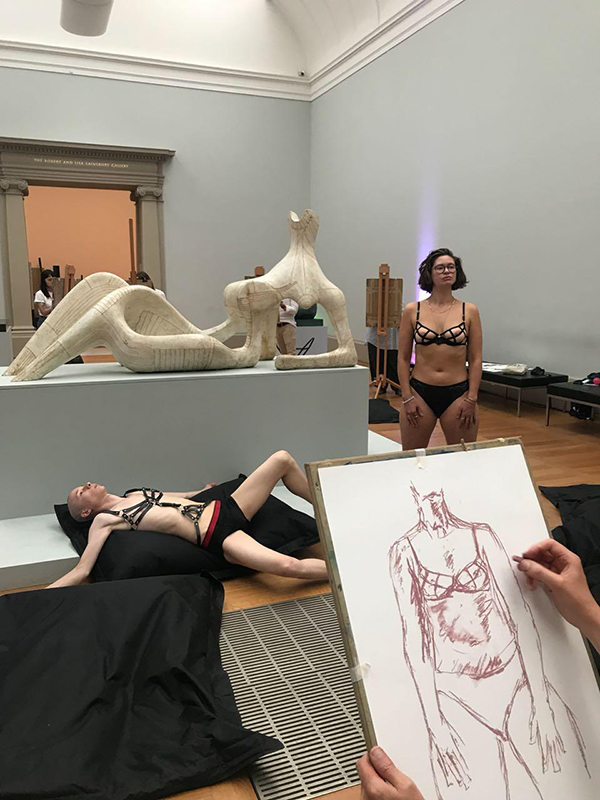Queerdirect Is Redefining How Art Institutions Designate Space to LGBTQI+ Individuals
Over the past year Queerdirect has taken over several London institutions, reimagining the gallery as a visible space for queer artists
Over the past year Queerdirect has taken over several London institutions, reimagining the gallery as a visible space for queer artists

In Peter Ackroyd’s 2017 book Queercity, he writes that urban landscapes have always been a place of home and haven for queer communities. Yet within cities, art institutions – much like all other institutions – have often failed to support the endeavours of LGBTQI+ identifiers, and the effects of such prolonged underrepresentation only furthers their marginalization. In such a climate it becomes crucial for artists to create alternative support platforms themselves and begs the question: if the route to traditional institutions has previously been blocked, what new pathways should queer artists establish themselves?
The artist support network Queerdirect was initiated by artist Gaby Sahhar in 2017 and co-directed with artist Lily Cheetah Nicol. It grew out of the need for queer artists to have access to longterm support and a network to promote their work. Both artists seek to experiment with societal narratives of gender and queer identity, and Queerdirect subverts the consensus of gender through its events in both large and small galleries. Together, the duo are reestablishing what it means to assert power, providing visibility for artists who might otherwise be hidden.

Over the past year Queerdirect has taken over several large institutions in London, reimagining the gallery as a space to allow visibility for queer artists. A four-week life drawing class in response to the ‘All Too Human’ exhibition at Tate Britain this summer saw thirty LGBTQI+ participants reenacting heteronormative scenes to queer the gaze of art galleries’ execution of gender. Unfolding the spectrum of gender binaries and re-thinking heteropatriarchal norms, it asked: how does the queer gaze relate to subjects outside assumed roles of sexuality while reconsidering heteropatriarchal structures?
Another event at Somerset House ‘Queer Networking’ worked to emasculate corporate aesthetics by reimagining how labour is disseminated in a heteropatriarchal society. By subverting its ‘corporate setting’, the event reconfigured networking as something which isn’t overtly bound to capitalism, linking it instead to principles of speed dating and queer sexuality. The event made apparent the architecture of labour while providing a feasible alternative to this within the confinements of its luxurious location.

Their latest exhibition ‘The Night Holds Its Breath’ currently at Unit 21 at the Penarth Centre in Bermondsey showcases nine LGBTQI+ artists. All confront queer nightlife, trans identity and activism while reflecting on their relations to the art market and their struggles to support their artistic practices. Vasiliki Antonopoulos's film Dry (2018) constructed an imaginary future comprised of glass, making apparent the current development of urban landscapes and the push toward a uniform identity. Brick is replaced with glass to create transparency, where mark-making is rendered as a form of resistance and public expression. Zero Fucks (2018) by Ishimoi Ishimwa utilizes movement to meditate on societal expectations of the body through a series of poems. Ishimwa’s approach to the body reminds us of the potential integrity of queer existence; to reject binaries and move fluidly both in oneself and in relation to others.

As the exhibition title suggests, the transitory space of private and public experiences is inherent to the documentation of queer life and are explored by Sahhar and Nicol’s work. Sahhar’s painting Can’t Get no Sleep (2018) is an intimate examination of the shame generated by male sexual desire and how such fantasies become oppressed through social stigma and pressure. The painting rendered in neon pink depicts a figure lying in bed masturbating. On the wall above are three clocks, reinforcing how the self is subject to repress such desires and emotions in the face of ever-present external pressures. In Talisthem (2018) Nicol proposes a queer archaeology through imagined iconography in a clay mythical sculpture comprised of a circle of stones, sea water and rocks collected from Derek Jarman’s garden creating a transtemporal sense of queer protection, history and power. Nicol reminds us that the immortality and mourning found in queer histories bear poignant relevance to climate change. As such, a range of ideas come into focus, capturing the complexities of queer identity in the present.
Queerdirect’s collaboration with institutions such as Somerset House and the Tate demonstrates that institutions are at last willing to correct the underrepresentation of queer artists. Their life drawing classes, making evident the lived, visceral experience of the queer existence. And if visibility harnesses new possibilities, creating alternative histories by reclaiming spaces for queer art is crucial. When institutions fail to represent LGBTQI+ artists consistently, artists must dictate their terms of their own visibility within the art world. Queerdirect is helping them do just that.
Queer Direct’s group show ‘The Night Holds Its Breath’ runs at Unit 21 Penarth Centre in Bermondsey, London, until 20 November.
Main image: Queer life drawing, 2018, Tate Britain. Courtesy: Queerdirect





















